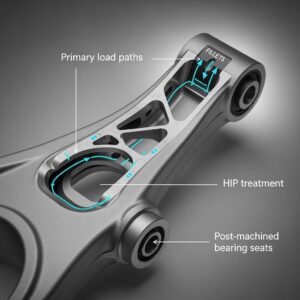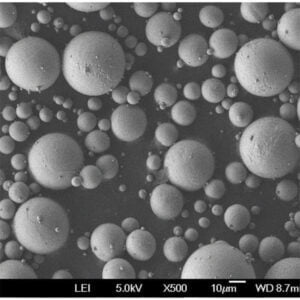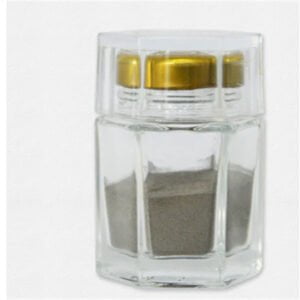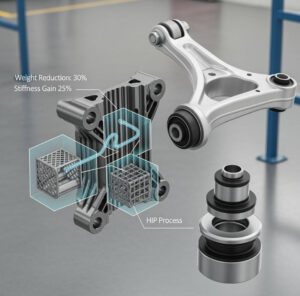3Dプリンティング用アルミニウムパウダー
目次
3D印刷用アルミニウムパウダー は、軽量で高強度な部品を作成するための積層造形において、さまざまな産業でますます使用されるようになっています。このガイドでは、3Dプリント用アルミニウム粉末の包括的な概要を説明します。
AM用アルミニウムパウダーの紹介
アルミニウムは、3Dプリントの素材として人気がある:
- 低密度 - 2.7 g/cc
- 高い比強度
- 優れた熱伝導性と電気伝導性
- 良好な耐食性
- 溶接性と機械加工性
- 低材料費
アルミニウム粉末の主な特性:
- 球状粉末の形態
- 制御された粒度分布
- 99.5%以上の高純度Al
- リサイクル・アルミニウムを原料とする場合もある
- バインダージェット、DMLS、SLMプロセスに使用可能
アルミニウム粉末は、他の方法では製造不可能な軽量部品の印刷を可能にする。
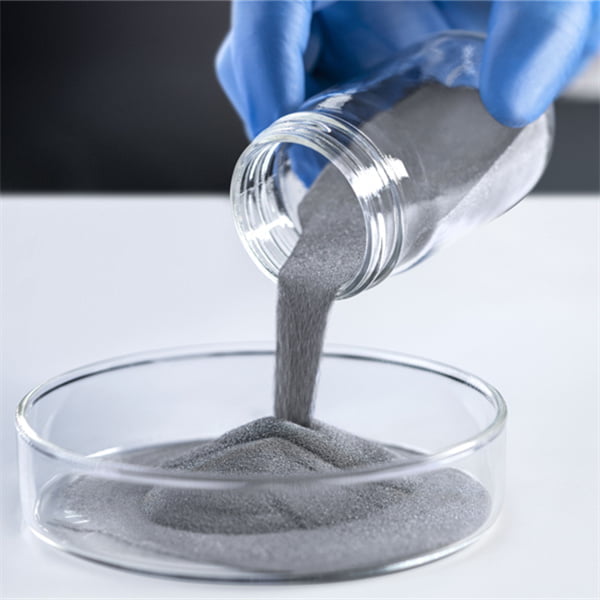
積層造形用アルミニウム粉末の種類
AMにはさまざまなアルミニウム合金粉が使用される:
3Dプリント用アルミニウムパウダーの種類
| タイプ | 説明 | アプリケーション |
|---|---|---|
| AlSi10Mg | シリコンとマグネシウムの鋳造合金 | 航空宇宙、自動車 |
| AlSi7Mg | Si、Mgを含む中程度の強度の合金 | 産業機械 |
| 6061 | Mg、Siを含む中強度錬合金 | カスタム・ブラケット、フィクスチャー |
| 5XXXシリーズ | 強度を高めるマグネシウム5 | 工具、船舶 |
| 純アルミニウム | アルミニウム合金 99.7 | 熱管理、電気 |
特殊な合金は、従来の合金の特性と一致させるために、添加技術に適合するようになってきている。
構成 3D印刷用アルミニウムパウダー
AM用アルミニウム合金粉末の典型的な組成:
アルミニウムプリントパウダーの組成
| 合金 | アル | Mg | Si | フェ | 銅 | ムン |
|---|---|---|---|---|---|---|
| AlSi10Mg | バル | 0.2-0.5% | 9-11% | 0.55 | <0.05% | 0.45 |
| AlSi7Mg | バル | 0.1-0.5% | 6-8% | <1% | <0.1% | <0.1% |
| 6061 | バル | 0.8-1.2% | 0.4-0.8% | 0.7% | 0.15-0.4% | 0.15 |
| 5056 | バル | 4.5-6% | 0.4% | <0.5% | <0.1% | 0.1-0.5% |
ケイ素は鋳造性と流動性を向上させる。マグネシウムは強度を高める。AM適性のために不純物は最小限に抑えられている。
アルミニウムプリントパウダーの主な特性
アルミニウムプリントパウダーの特性
| プロパティ | 価値 |
|---|---|
| 密度 | 2.7 g/cc |
| 融点 | 475-650°C |
| 熱伝導率 | 120-180 W/mK |
| 電気伝導度 | 35-38 MS/m |
| 引張強さ | 230-520 MPa |
| 伸び | 3-8% |
| ヤング率 | 68~72GPa |
| 硬度 | 65-100 HB |
この特性により、アルミニウムは軽量で熱伝導性、電気伝導性の高い印刷部品に適している。
AM用アルミニウムパウダーの特性
アルミニウムパウダーの特徴
| パラメータ | 詳細 | 意義 |
|---|---|---|
| 粒子形状 | 球形 | 流動性の向上 |
| サイズ分布 | 10-100 μm | 部品の分解能を制御 |
| 見かけ密度 | 1.2-1.8 g/cc | 最終部品の密度に影響 |
| 流量 | 20~30秒/50g | 粉体の散布性を示す |
| 酸化物含有量 | < 3% | 粉末の流動と焼結への影響 |
| 水素含有量 | < 0.15% | 部品の気孔率を低減 |
真球度と粒度分布の制御は、アルミニウムAM粉末にとって非常に重要である。
アルミプリントパウダーの仕様
アルミパウダー仕様
| パラメータ | 範囲/限界 | スタンダード |
|---|---|---|
| 粒子径 | 10-63 μm | ASTM B214 |
| 見かけ密度 | 0.80 g/cc | ASTM B212 |
| ホール流量 | <30秒/50g | ASTM B213 |
| 酸化物含有量 | < 3% | ASTM B237 |
| Mg、Si組成 | 合金限界 | ASTM B937 |
| 不純物 | Fe、Cu、Mn制限 | ASTM B937 |
主要な粉末の特性と組成は、標準化された仕様に照らして検証される。
使用するメリット 3D印刷用アルミニウムパウダー
3Dプリンティングにおけるアルミニウムの利点
- 軽量化 – 高い強度重量比
- 材料廃棄の削減
- 設計の自由度の向上と部品の統合
- 工具と機械加工の排除
- オンデマンドおよびジャストインタイム製造
- 高い熱伝導性と電気伝導性
- 優れた耐食性
- 優れた仕上げと後処理
- 中量生産における費用対効果
アルミニウム粉末積層造形は、軽量構造部品や機能部品の製造において、従来の技術よりも大きな利点を提供する。
3Dプリントアルミニウム部品の用途
3Dプリンテッドアルミニウムの産業用途
| 産業 | コンポーネント |
|---|---|
| 航空宇宙 | 機体ブラケット、熱交換器、タービンブレード |
| 自動車 | シャシー、パワートレイン部品、カスタム・インテリア |
| インダストリアル | ロボット工学、工具、治具、マウント |
| 消費者 | 電子機器ハウジング、ドローン本体 |
| 建築 | 装飾パネル、壁材 |
| メディカル | 整形外科用インプラント、人工装具 |
積層造形は、さまざまな分野において、これまで不可能だったアルミニウムの形状、統合、カスタマイズを可能にする。
アルミニウムプリンター用パウダーサプライヤーの選び方
アルミニウム粉末サプライヤーの選択
- AMパウダーの製造経験
- 合金と粒子径のカスタマイズが可能
- 一貫した品質と再現性
- 競争力のある透明性の高い価格設定
- 技術的専門知識と顧客サポート
- バッチ分析と認証データ
- 在庫とリードタイムの短縮
- 需要変動への対応能力
- 責任ある持続可能な調達
信頼できるアルミニウムパウダーのパートナーは、アプリケーションの要件に合わせてカスタマイズされた高品質のパウダーを提供します。
アルミプリントパウダーメーカー
AM用アルミニウム粉末サプライヤー
| 会社概要 | 所在地 |
|---|---|
| サンドビック | ドイツ |
| エーピーアンドシー | カナダ |
| プラクセア | アメリカ |
| カーペンター添加剤 | アメリカ |
| 高度なパウダーとコーティング | アメリカ |
| LPWテクノロジー | 英国 |
これらの大手サプライヤーは、最適な印刷を保証するために、制御された粒子径、球状形態、カスタム合金、および広範な認定データを提供します。
アルミニウムプリントパウダーのコスト分析
アルミパウダー・コスト
| グレード | kgあたりのコスト |
|---|---|
| 純アルミニウム | $50-$100 |
| AlSi10Mg | $55-$120 |
| 6061合金 | $60-$150 |
| 5XXXシリーズ | $65-$140 |
価格は合金組成、不純物レベル、粒子特性、購入量によって異なる。チタン合金に比べて大幅なコスト削減が可能。
アルミニウムと他の印刷材料との比較
アルミニウムパウダーと代替品の比較
| パラメータ | アルミニウム | チタン | ステンレス鋼 |
|---|---|---|---|
| 密度 (g/cc) | 2.7 | 4.5 | 8.0 |
| 引張強さ (MPa) | 230-520 | 900-1200 | 500-1000 |
| 熱伝導率 (W/mK) | 120-180 | 7-16 | 15-30 |
| 電気伝導率 (MS/m) | 35-38 | 2.4 | 1.5 |
| kgあたりのコスト | $50-$150 | $200-$500 | $20-$50 |
| 印刷適性 | フェア | 難しい | 素晴らしい |
アルミニウムは強度、重量、導電性、コストの面で最高の組み合わせです。ステンレス鋼は印刷しやすいが重い。チタンは難しい。

よくある質問
Q: アルミニウムAMパウダーの一般的な粒子径はどのくらいですか?
A: 10-45ミクロンの粒径が一般的で、最適なフローと高分解能を得るために20-35ミクロン付近で密に分布しています。
Q: 3Dプリンティングに適合するアルミニウムのグレードは何ですか?
A: AlSi10Mg、AlSi7Mg、6061のような6XXX系合金が認定されています。5XXXグレードも高強度で人気を集めています。
Q: アルミニウムに最適なAMプロセスはどれですか?
A: DMLS、SLM、バインダージェットでアルミ印刷が可能です。バインダージェットは造形速度が速いですが、DMLSとSLMは機械的特性が優れています。
Q: アルミニウムパウダーは特別な取り扱いが必要ですか?
A: 細かく分割されたアルミニウムは、空気中で可燃性または爆発性を示すことがあります。保管および取り扱いには不活性ガス用グローブボックスの使用を推奨する。
Q: 3Dプリントしたアルミニウムに熱処理は必要ですか?
A: はい、溶体化処理、時効処理、アニール処理、応力除去を行い、望ましい材料特性と微細構造を得ることができます。
Q: アルミニウムAM部品ではどのような表面仕上げが可能ですか?
A: 約15ミクロンRaのアズプリント仕上げは、メディアブラスト、グラインディング、サンディング、ポリッシングを使用して、さらに1ミクロンRa以下に平滑化することができます。
Q: アルミニウム印刷部品はバルク合金の特性と一致しますか?
A: パラメータと後処理を最適化することで、積層造形部品は従来加工されたアルミニウム合金と同等以上の機械的特性を達成することができます。
Q: アルミニウムAMにはどのような設計原則が適用されますか?
A: 印刷の向き、最小限のサポート、余裕のある内部半径、熱応力を考慮することで結果が向上します。肉厚は1mm以上が好ましい。
Additional FAQs about Aluminum Powder for 3D Printing
1) What oxygen and moisture limits should I target for Aluminum Powder for 3D Printing?
- Aim for O ≤ 0.06–0.10 wt% for general parts and ≤ 0.05 wt% for fatigue-critical parts; moisture ≤ 0.03 wt%. Pre-dry powder at 80–100°C for 2–4 hours and maintain O2 ≤ 100 ppm in the build chamber.
2) Which particle size distribution performs best for PBF-LB vs Binder Jetting?
- PBF-LB/SLM: 15–45 µm (or 20–63 µm on some platforms) with sphericity ≥ 0.95 for flowability and packing.
- Binder Jetting: 20–80 µm optimized for spreadability and green density; requires tuned debind/sinter cycles.
3) What post-processing routes maximize properties for AlSi10Mg and 6061?
- AlSi10Mg: stress relief 280–320°C (2–3 h), optional HIP (100–120 MPa, 450–520°C), artificial aging 160–180°C (6–8 h), plus shot peening/chemical polishing for fatigue.
- 6061: solutionize 520–540°C, quench, age 160–180°C to T6-like temper; HIP if porosity-sensitive.
4) How much recycled powder can be blended without degrading quality?
- Many production lines validate 30–60% reuse with closed-loop sieving (e.g., 45 µm), PSD checks, magnetic separation, and O/N/H monitoring per ISO/ASTM 52907. Always confirm with witness coupons.
5) What safety measures are essential for handling fine aluminum powders?
- Treat as combustible metal dust: use grounded equipment, inert handling where feasible, Class II dust collection, avoid dry sweeping, and follow NFPA 484. Keep away from oxidizers and ignition sources.
2025 Industry Trends: Aluminum Powder for 3D Printing
- Throughput gains: Widespread adoption of 50–80 µm layers and multi-laser systems (2–4+) cuts cycle time 15–35% for AlSi10Mg.
- Fatigue consistency: Standardized finishing (shot peen + chemical/abrasive flow polishing) narrows HCF scatter for aerospace and e-mobility brackets.
- Hybrid thermal modules: Co-print/join strategies pair Al heat exchangers with Cu inserts to boost thermal performance.
- Sustainability: Higher certified powder reuse ratios, inert gas recirculation, and genealogy tracking reduce cost and footprint.
- Standards maturity: Broader OEM allowables and new guides for aluminum PBF design/post-processing improve cross-fleet repeatability.
Table: Indicative 2025 benchmarks for Aluminum Powder for 3D Printing (PBF-LB focus)
| メートル | 2023 Typical | 2025 Typical | 備考 |
|---|---|---|---|
| Powder oxygen (wt%) | 0.06–0.12 | 0.04–0.08 | Better atomization and packaging |
| Mean sphericity | 0.93–0.96 | 0.95–0.97 | Improved flow/packing |
| Layer thickness (µm) | 30–50 | 40–80 | With optimized scan vectors |
| As-built density (%) | 99.4–99.7 | 99.5–99.8 | Stable atmosphere + calibration |
| UTS after heat treatment (AlSi10Mg, MPa) | 420–460 | 440–490 | HIP + aging + finishing |
| Surface roughness Ra vertical (µm) | 10–18 | 7–14 | Strategy + chem/shot finish |
| Powder reuse fraction (%) | 20-40 | 30~60歳 | With O/N/H and PSD control |
| Cost/part vs 2023 | - | −10% to −20% | Multi-laser + reuse + automation |
Selected references and standards:
- ISO/ASTM 52907 (metal powders), ISO/ASTM 52908 (post-processing), ISO/ASTM 52910 (DfAM)
- ASTM F3571 (Guide for design with aluminum PBF), ASTM E8/E8M (tension)
- NIST AM-Bench datasets and reports: https://www.nist.gov/ambench
- OEM guides: EOS, GE Additive, SLM Solutions (Aluminum AM datasheets)
Latest Research Cases
Case Study 1: Multi-Laser AlSi10Mg Brackets for EV Platforms (2025)
Background: An EV OEM needed lighter brackets with improved fatigue life and lower cost.
Solution: 4-laser PBF-LB; 60–70 µm layers; argon O2 < 50 ppm; stress relief 300°C/2.5 h; optional HIP; shot peen + chemical polish; 40% powder reuse with O/N/H tracking.
Results: Build time −28%; UTS 470–485 MPa, YS 290–310 MPa, elongation 8–10%; HCF limit +12% vs 2023 baseline; cost/part −16%.
Case Study 2: Binder-Jetted Aluminum Heat Exchanger Cores (2024)
Background: An HVAC supplier sought compact, corrosion-resistant cores with complex channels.
Solution: PSD 20–80 µm; high green-density binder; debind + pressureless sinter; HIP; chemical polishing; helium leak testing ≤ 1×10⁻⁹ mbar·L/s.
Results: Final density 99.3–99.6%; thermal resistance −14% vs brazed Al cores; leak rates within spec; unit cost −18% at 1,000 pcs/year.
専門家の意見
- Prof. Iain Todd, Professor of Metallurgy and Materials Processing, University of Sheffield
Viewpoint: “Controlled preheats and tuned scan vectors enable thicker layers in AlSi10Mg without compromising density—key to industrial throughput.” - Dr. Laura Cotterell, AM Materials Lead, Aerospace OEM
Viewpoint: “Powder genealogy plus standardized finishing is central to tightening fatigue scatter for flight-adjacent aluminum hardware.” - Dr. Christoph Schmitz, Head of AM Process Development, Tier‑1 Automotive
Viewpoint: “Validated 40–60% powder reuse with strict O/N/H limits yields real cost reductions while preserving tensile and leak performance.”
Practical Tools and Resources
- ISO/ASTM AM standards – https://www.astm.org/ | https://www.iso.org/
- NIST AM‑Bench (datasets, benchmarks) – https://www.nist.gov/ambench
- SAE/AMS resources for AM allowables – https://www.sae.org/
- OEM datasheets/process guides (EOS AlSi10Mg, GE Additive) – https://www.eos.info/ | https://www.ge.com/additive/
- ASM International finishing references (shot peen, chem polish) – https://www.asminternational.org/
- NFPA 484 (combustible metals) and MPIF safety – https://www.nfpa.org/ | https://www.mpif.org/
- Open-source design/simulation: OpenFOAM (thermal/fluids), pyVista (geometry/CT) – https://www.openfoam.com/ | https://github.com/pyvista/pyvista
SEO tip: Use keyword variants like “Aluminum Powder for 3D Printing parameters,” “AlSi10Mg HIP and aging,” and “aluminum AM powder reuse and oxygen limits” in subheadings, image alt text, and internal links.
Last updated: 2025-10-14
Changelog: Added 5 targeted FAQs; provided 2025 benchmarks and trends table; included two recent case studies; added expert viewpoints; curated practical resources and safety standards; appended SEO keyword guidance
Next review date & triggers: 2026-04-15 or earlier if ISO/ASTM/AMS standards update, OEM process windows change materially, or new datasets revise recommended oxygen/reuse/heat-treatment practices
シェアする
MET3DP Technology Co., LTDは、中国青島に本社を置く積層造形ソリューションのリーディングプロバイダーです。弊社は3Dプリンティング装置と工業用途の高性能金属粉末を専門としています。
関連記事
